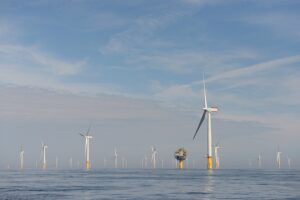British oil & gas supermajor BP expects the average annual increase in wind and solar capacity over the next 15 years could reach as high as 350GW or even 550GW, and push the share of renewable energy in the global energy mix to almost 60% by 2050.
In the now tenth year of its annual Energy Outlook, BP is expecting renewable energy and a global low-carbon shift to be the dominant features of the future. And while BP’s Energy Outlook reports are not intended as a predictor of the future, the three potential scenarios laid out in this year’s report nevertheless lay out a range of avenues to a low-carbon world.
“The role of the Energy Outlook is not to predict or forecast how the energy system is likely to change over time,” said BP’s chief economist, Spencer Dale. “We can’t predict the future; all the scenarios discussed in this year’s Outlook will be wrong.
BP’s Energy Outlook presents three scenarios – Rapid, Net Zero, and Business As Usual (BAU), all of which see global energy demand increasing, driven by increasing prosperity and living standards in the emerging world.
However, primary energy demand plateaus in the second half of the Outlook out to 2050 in the Rapid and Net Zero scenarios thanks to improvements in energy efficiency, whereas demand continues to grow throughout the 30-year Outlook in the BAU scenario, increasing by as much as 25% by 2050.
This leads into the Outlook’s second key theme, that of the fundamental restructuring of global energy systems driven by a focused transition to a lower carbon energy system.
All three scenarios show a decline in the global energy system for fossil fuels and a corresponding increase in renewable energy, but the scale of this shift varies significant across the three scenarios. In 2018, hydrocarbons in primary energy sat at 85%, but will fall by anywhere from 65% to only 20% by 2050, depending on which scenario plays out. In turn, renewable energy will increase by anywhere from 20% to 60%.
The Outlook sees falling demand for oil over the next 30 years – with demand declining by 10% by 2050 in the BAU scenario, by 55% in the Rapid scenario, and by as much as 80% in the Net Zero scenario.
Importantly, the BAU scenario sees oil demand plateauing in the early 2020s, whereas in both the Rapid and Net Zero scenarios “oil demand never fully recovers from the fall caused by COVID-19.”
Conversely, global demand for natural gas remains resilient, and varies significantly across the scenarios. It peaks in the mid-2030s in the Rapid scenario and in the mid-2020s in the Net Zero scenario, whereas in the BAU scenario gas demand increases over the next 30 years to be approximately a third higher by 2050.
One of the key focuses of the report is, unsurprisingly, on the role of renewable energy in the global energy mix. Whereas renewable energy generation only accounted for around 5% of primary energy in 2018, it increases to 60% by 2050 in the Net Zero scenario and 45% in the Rapid scenario, while eking out only 20% in the BAU scenario.
Wind and solar obviously dominate this growth thanks in large part to continued falls in development costs, which could fall by as much as 30% and 65% by 2050 for wind and solar respectively in the Rapid scenario, and 35% and 70% in the Net Zero scenario.
Needless to say, however, the potential growth requires a significant acceleration in the build out of renewable energy generation capacity, and the Outlook envisions the average annual increase in wind and solar capacity over the first 15 years of the Outlook at around 350GW for the Rapid scenario and a mammoth 550GW for the Net Zero scenario, as compared to the annual average of only 60GW that we’ve seen since 2000.
The full 2020 Energy Outlook is available to read here.










